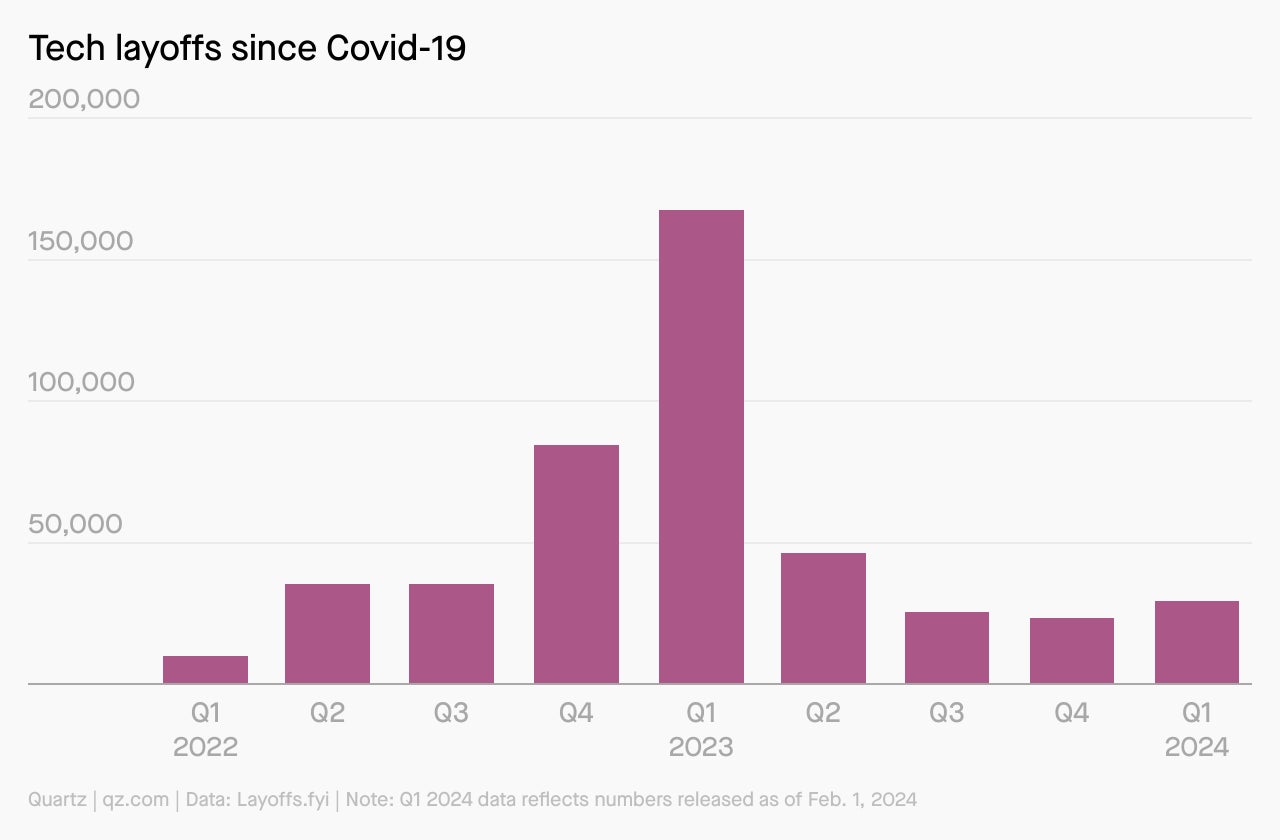The pink slippers of Silicon Valley
The US tech sector is booming—so why are companies laying thousands of people off?


Hi, Quartz members,
For days now, Quartz has been tracking the layoffs at tech companies: more than 24,000 in just the first month of 2024. They range from the smallest companies to the biggest. Microsoft broke into the $3 trillion market valuation club, for instance, but it still let 1,900 employees in its gaming division go. Discord cut 17% of its workforce; Unity Software, a video game developer, plans to slash a quarter of its staff, amounting to roughly 1,800 positions; Duolingo, the language learning platform, cut 10% of its contract employees; Twitch, the live streaming site, is laying off more than a third of its staff. The bad news for tech workers came thick and fast in January.
It may also have been puzzling news, given that 2023 was such a bumper year for tech companies. Nasdaq, the tech-heavy index, finished the year up 43%. Microsoft saw its gross margin exceed 71% since 2013; in its last quarter, its gaming revenue—the very division that witnessed deep layoffs last month—rose by 49% to $7.11 billion. Salesforce’s annual gross profit for 2023 increased 18% from the previous year, to around $23 billion. And while the Fed’s interest rate cuts may not be around the corner, they’re expected as early as the summer, which will rejuvenate consumption further.
So the newly laid off tech professional, packing their desk up into a cardboard box or sending their work laptop back, can be forgiven for asking: What gives, tech companies? Why the layoffs now?
CHARTED

THE RULE OF THREE
There are at least three factors behind the rationale of tech companies laying employees off:
🤖 Artificial intelligence: It may feel as if AI is touted as a reason for practically every corporate move these days. But in the case of the tech sector, it’s a genuine trigger for some layoffs. Take Duolingo. A number of its laid-off (or “offboarded,” to use the company’s clumsy term) contractors are writers and translators, who will be replaced by algorithms. SAP, the enterprise software developer, is going through a restructuring that will affect 8,000 jobs, which will allow new investments into its AI work. Either workers are watching their jobs being automated, or their pay packets are being diverted to hiring AI talent.
📈 Earnings, earnings, earnings: For a company like Amazon, a Bloomberg Intelligence analyst remarked, job cuts are “likely just a move to further streamline costs and improve efficiency to increase earnings.” In the quest to buttress the bottom line, the glut of pandemic recruitment has been unwinding in stages ever since early 2023, and January’s layoffs form one more iteration. To ensure investors and shareholders are patient with long development cycles of new products—such as (that phrase again!) artificial intelligence models—companies are keen to steady their profits in the near term. And boosting earnings is also a way of shaking the persistent murmur that tech companies, with their high price-to-earnings ratios, are overvalued.
💲 M&A season: In 2023, merger and acquisition activity slowed dramatically—down 25% from the previous year. This year, as the cost of capital is expected to drop, M&As are likely to pick up again. For companies, this means cutting their costs (read: staff) ahead of a merger or a sale—or layoffs after a deal. When Hewlett Packard announced its acquisition of Juniper Networks for $14 billion, its CEO also indicated to Bloomberg Television that staff cuts were imminent.
QUOTED
It’s more of a reallocation than anything else, because 95% of the cost-cutting is in the rear-view mirror. But the strong are going to get stronger and the weaker hands are going to be exposed.
— Dan Ives, a Wedbush analyst, discussing the layoffs with the Guardian
ONE 🧨 THING
If a tree falls in the forest and it isn’t captured on TikTok, does it still make a sound?
Young tech professionals capture so many other parts of their day on social media that it was inevitable they’d record being laid off as well. Brittany Pietsch uploaded a nine-minute video of herself being let go by the IT firm Cloudflare. Chloe Shih, hands cupped over her mouth, watched an executive deliver the “difficult decision” about layoffs at her company. (She’d just bought a house too!) A user named Jewish Millennial, certain of her fate, noted how her meetings kept getting canceled, one after another—even as a 30-minute call with her boss’s boss, whom she’d never met before, loomed later in the day. It may not be the kind of move a headhunter recommends; employers are increasingly making hiring decisions based on the social media lives of candidates. But the videos are also evidence of the poor ways in which employers handle layoffs—and of workers’ cynical dissatisfaction with their companies. When the revolution comes, it may not be televised—but watch out for the TikTok hashtag.
Thanks for reading! And don’t hesitate to reach out with comments, questions, or topics you want to know more about.
Have a weekend free of employment shocks,
— Samanth Subramanian, Weekend Brief editor